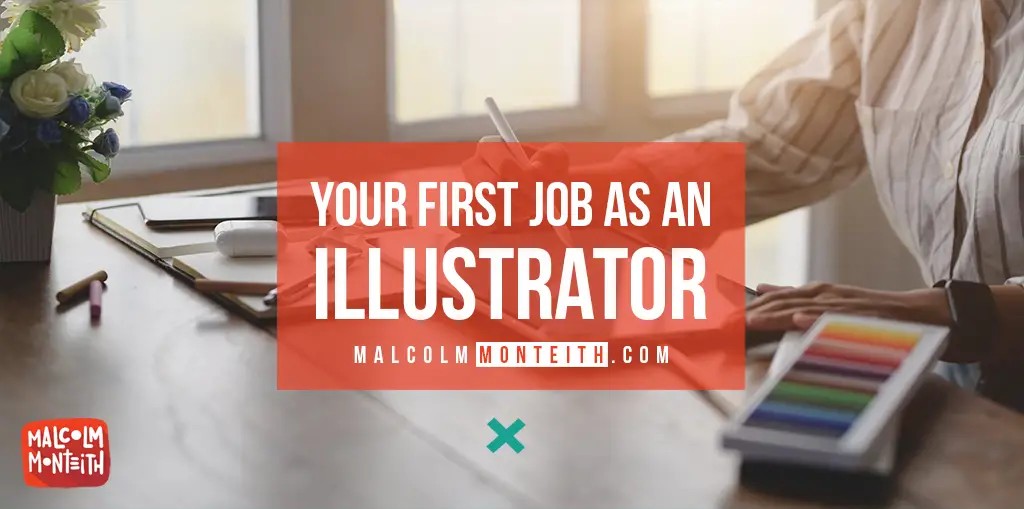
Sooo you have just finished your illustration / design course or perhaps you are contemplating pursuing a new career as an illustrator. The logical step now is to break into the illustration industry.
If you are wondering how to get your first illustration job, you will need two things: A high-quality portfolio and customers who know you exist.
If you don’t have either of these, fear not, friend. I am about to take you through the steps you can take in order to put you on the path to achieving illustration greatness! (or at the very least, a bit of income).
In this article I will also share with you some of my own personal experiences which will hopefully help you along in your upcoming art adventures.
(By the way, if you are new to illustration, check out my main article on how to become an illustrator!)

Illustration Portfolio Tips
Before anyone will consider hiring you, you will need a portfolio of your best illustrations. An illustration portfolio will be the proof of your abilities. Prospective clients will need to see this before they can hire you.
Illustration Portfolio Checklist
To create an illustration portfolio, you will need:
- A good understanding of who your target audience is
- 10 – 12 pieces of work that you are proud of
- Consistent quality across all of your illustrations
HANG ON… I didn’t mention your qualifications…
Can you be an illustrator without a degree?
You do not need a degree to become an illustrator. The most important things are your illustration portfolio and your work ethic.
From my personal experience, (whether I was working as an illustrator for a company or as a freelance illustrator), never once was I ever asked about my qualifications – people were only interested in my work.
But that doesn’t mean studying illustration is a waste of time. For those of you who have had formal training, you will most likely already have a solid portfolio which you are now ready to aggressively wave around in the faces of your prospective employers.
So if you have had formal training in the field of illustration, that is great. But you will need to back this up with a beautiful body of work.
Remember that being able to draw well and have great ideas will be valued more than someone with a gold plated illustration PhD who can only draw stickmen.
Know Your Customer
Imagine that you are wanting to apply for jobs to illustrate children’s books. Buuut your portfolio is peppered with medical diagrams or architectural sketches. Chances are employers/clients won’t have any idea of (or confidence in) your children’s book illustrating abilities.
It is important that your portfolio is a good representation of the field you are wanting to work in. Remember that there are so many different types of illustration jobs out there. If you are able to illustrate in different styles across different fields, then don’t be shy to have more than one portfolio (just like how some people tailor their resumes for different types of jobs).
Use a Dummy Design Brief
If you are struggling to come up with pieces to exhibit in your portfolio, then I recommend that you come up with some fictitious briefs that you can work on in your spare time. You can either make up the brief yourself, or use a brief generator website.
Reach out to Your Community
Another thing you could reach out to your circle of friends, colleagues or classmates and offer to help them with any illustrations they need (But please go easy on this one, I don’t want people to start calling you the ‘Benevolent Illustrator of Zero Cost Services’ behind your back. Please protect your reputation)
Also, don’t be shy to ask your friends to spread the word about your services. Word of mouth is a wonderful thing
Now what?
Once you have created a solid portfolio that is up to your high standards of quality (and quantity), you will then need to put it up on a website. There are free websites where you can host your work (such as Artstation or Instagram) or you can create your own website and showcase your images on there.
With your portfolio ready to go, next up is the very important step of (what the cool kids call) hustlin’.
Go Forth – Get Those Customers!
There are two paths you can go down here: Freelance Illustration or working for an employer in a longer-term illustration job.
Option 1: Freelancing
Freelance Illustrating can be a great way to work for some people. Freelancers work their own hours and often don’t need to commute everyday to an office.
The hard part is building up your customer base.
How to Find Clients for Illustration
There are many ways to find illustration clients, such as using Illustrator for Hire Websites, teaming up with an agent, word of mouth and getting to know other illustrators.
Let’s discuss a few of these…
Using Illustrator for Hire Websites
Take a look at websites like 99designs, Fiverr and Upwork. I’ve always got the vibe that they are geared more in favour of the customers, but take a look around and see if these sites are an avenue you’d like to go down.
Getting an Agent
Jump on Google and see what agents there are in your area (Agents don’t have to be where you live, but I always preferred working in the same city/town as my clients).
Networking / Word of Mouth
Personally, this one worked very well for me back in my freelancing days. Do you frequent small businesses in your area? Tell them you’re a freelance graphic artist. Do they seem intrigued? Bust out your phone and show them your portfolio.
Every conversation you have increases the probability of meeting a future client.
Getting to know other illustrators
Whether it’s Facebook groups, forums or real-life humans, socialising is important (and fun). There were times when other artists who were unable to do a job would contact me and ask if I was interested in picking it up. Nek minute! I landed a client. It’s not what you know, but who you know (and who knows you, as well!)
Do Your Best
When working with your first illustration client, doing a great job will increase your chances of getting another project.
If you’ve delivered a great product, with a good attitude and in a timely manner, then:
- Your client will recommend you to their friends and colleagues
- Your client will use your illustration services again and again
- Other people will see your work and will want to hire you
Word of mouth is a powerful tool for illustrators and designers – the more illustration gigs you pick up, the higher the chances are that you will find a few regular and ongoing clients to work with.
Keep in Touch
Make sure you build a good rapport with everyone you work with – the one thing more important than what you do for clients, is how you make them feel.
If your client decides to keep using you for other designs, that’s great! If not, please make the effort to keep in touch with them. Check in with them from time to time, see how they’re doing etc. This will maintain your professional relationships and keep you fresh in their minds.
Other people seeing your work will potentially open doors to other jobs. Exposure is fantastic – buuut only if you’re getting paid money for that exposure… Which leads me to this very important point…
Know Your Worth
I am reminded of the very wise words spoken by Heath Ledger’s Joker: “If you’re good at something, never do it for free”. For some messed up reason, society believes artists can survive on this magical currency called Exposure. If anyone approaches you with a work request, and they are not paying you in real life grown-up dollar-e-doos, kindly tell them to keep walking. Until the day that your grocery, water and electricity bills accept the currency of Exposure, always make sure you’re getting paid.
When Should You Get Paid?
You will need to do what is comfortable for you. But I suggest you protect yourself. For example, once you have agreed on the fee they are paying you, let them know that you will require 50% up front. That way, if they don’t go ahead with the project, you’ve at least secured half of your pay.
Option 2: Employment
If you are looking to work as an in-house illustrator, you will need to apply for jobs. In addition to having a portfolio, you will also need to write up a resume.
Curriculum Vitae / Resume
For your Illustration resume, you will need to include the following:
Contact Details: Name, Email, Phone number
Website: Include the link to your online portfolio
About Me: Talk about who you are and your professional/technical/interpersonal skills
Work Experience: List each job and what you achieved (starting with the most recent one). You are applying for your first illustration job, but remember that there are many skills that can be applied across all fields of work, so don’t discount your previous jobs.
Education: Where you studied (Didn’t study design or art? Doesn’t matter – all qualifications are important, it shows that you have the work ethic and the smarts to finish something.
Referees: Preferably two people who have worked closely with you and who can vouch for your character and work ethic.
Set Up a LinkedIn Profile
LinkedIn has become more and more important for people wanting to network with other people in their fields of work. Set up your profile and make sure to connect with other illustration professionals and companies that you would like to work for.
Apply for Illustration Jobs
Sign up to all of your country’s major job search websites and get searching! (LinkedIn will have job listings too). Use search terms relevant to your line of work. For Example, 2D Graphic Artist, Digital Artist, Visual Designer, Graphic Designer.
Talk to Recruiters
Pick up the phone and call some recruiters in your area – if they have a job that would fit your skillsets, they’ll get you in touch with the hiring manager for that company.
If they have no jobs available for you, they will at least now know who you are and may very well keep you in mind for when a job comes across their desk in future.
Let’s Recap!
I hope this article has helped give you some ideas on how to get your first illustration job. We have covered a lot of ground here, but going back to the beginning – remember that in order for you to get your first illustration job, you will need a high-quality portfolio and people who know about you.
Whether you are going down the path of freelance illustrator or in-house artist, remember to know your worth. If you are getting paid the money that you feel you’re worth, then this will show in the work you create!
If you produce great work and follow the advice in this article, I am confident you will be on your way to landing your first illustration job.
Best of luck!
Malcolm

4 thoughts on “How to Get Your First Illustration Job (With 2 Important Things)”